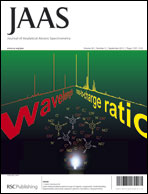Application of mass spectrometric isotope dilution methodology for 90Sr age-dating with measurements by thermal-ionization and inductively coupled-plasma mass spectrometry
Abstract
Application of an isotope-dilution method for determining 90Zr and 90Sr in a 90Sr source material spiked with 86Sr and 92Zr is described. A miniature gas pressurized


 Please wait while we load your content...
Please wait while we load your content...